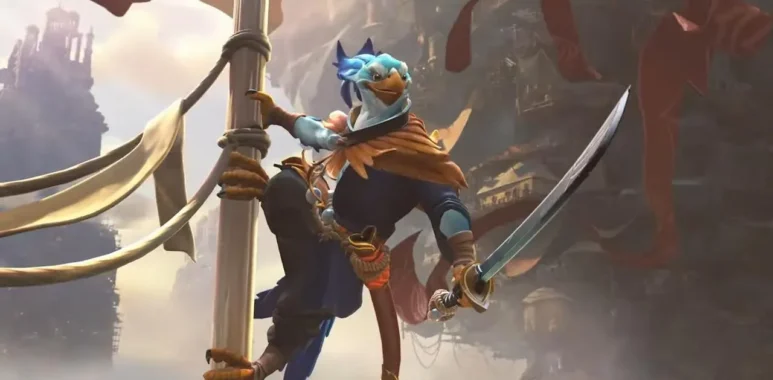
Dota 2: The Esport Defining Game
Few games have had as much of an impact on the competitive gaming industry as Dota 2. With one of the most intricate gaming systems and the biggest prize pools in esports history, Dota 2, which was released by Valve Corporation in 2013, has become a worldwide esport sensation. Dota 2 is still a mainstay in the esports sector thanks to its intricate strategy, fierce team chemistry, and active community.
The Story Behind Dota 2
Defence of the Ancients (DotA), a community-made mod for Blizzard’s well-known game Warcraft III: Reign of Chaos, has a sequel called Dota 2. DotA immediately gained a devoted player community thanks to its creative fusion of role-playing and real-time tactics components. But the game didn’t really take off on a worldwide scale until Valve built Dota 2 and purchased the rights to DotA.
 Dota 2’s July 2013 standalone release was eagerly awaited, and Valve made every effort to improve the game’s fundamental gameplay while also including contemporary graphics, a strong matchmaking system, and frequent updates. Since then, the game has undergone several upgrades that have improved gameplay balance and added new features, making it one of the most complex and well-liked esports games.
Dota 2’s July 2013 standalone release was eagerly awaited, and Valve made every effort to improve the game’s fundamental gameplay while also including contemporary graphics, a strong matchmaking system, and frequent updates. Since then, the game has undergone several upgrades that have improved gameplay balance and added new features, making it one of the most complex and well-liked esports games.
Overview of the Gameplay
Two teams of five players battle in the Multiplayer Online Battle Arena (MOBA) game Dota 2 to destroy the Ancient, the enemy team’s base within their walled stronghold. In order to outmanoeuvre and outplay the opposition, each player takes control of a different hero with unique talents and powers.
 Because it requires knowledge of hundreds of heroes, equipment, mechanics, and strategies, the game is notorious for having a high learning curve. Each of the many roles that heroes may play—carry, support, offlane, and mid—requires a unique combination of skills. Dota 2’s intricacy stems from its focus on resource management, hero choosing, team cooperation, and in-game decision-making, which makes it both difficult and rewarding.
Because it requires knowledge of hundreds of heroes, equipment, mechanics, and strategies, the game is notorious for having a high learning curve. Each of the many roles that heroes may play—carry, support, offlane, and mid—requires a unique combination of skills. Dota 2’s intricacy stems from its focus on resource management, hero choosing, team cooperation, and in-game decision-making, which makes it both difficult and rewarding.
The International: The Ultimate Esports Competition
The International (TI), a yearly competition run by Valve that has grown to be the most prominent esports event, serves as the focal point of Dota 2’s competitive scene. The huge prize pool of The International, which is financed by community in-game Battle Pass purchases, is what makes it unique. The prize pool has increased rapidly since 2013, reaching a record of over $40 million at TI10 (2021), the largest in esports history.
The International is a celebration of the game and its community in addition to providing players with potentially life-altering financial rewards. Regional qualifiers include teams from throughout the globe, culminating in a thrilling grand finale where the top teams compete for the Aegis of Champions. From historic comebacks to dominating performances by renowned teams like OG, Team Secret, and Evil Geniuses, this event has delivered some of the most memorable moments in esport history.
In addition to The International, Dota 2’s standing as a top esport has been cemented by a number of other significant competitions, including the Dota Pro Circuit (DPC), ESL One, and DreamLeague. In order to assist players and teams maintain their form going into the TI season and win valuable points, these tournaments offer year-round competition.
 Heroes and Complexity: Dota 2’s Core
Heroes and Complexity: Dota 2’s Core
The wide variety of heroes in Dota 2, each with unique skills, roles, and tactics, is what really sets the game apart. There are more than 120 heroes in the game right now, and each one counters foes and offers unique synergies when teamed with allies. Because teams must carefully choose their heroes to form the most potent combos while simultaneously preventing their opponents from making powerful selections, draughting becomes an essential aspect of the game.
Every hero has a unique playstyle, a rich past, and legend. Heroes like Pudge, a melee hero renowned for his lethal hook, and Invoker, with his complex spell-casting skills, have become legendary figures in the Dota 2 community. To get the most out of these characters in battle, players must become proficient in their timing, item builds, and mechanics.
Dota 2’s complexity goes beyond just choosing heroes. To get an edge over the other team, strategies like jungle farming, denying, last-hitting, and warding are crucial. Because Valve often adds new heroes, gear, and balancing adjustments to the game, the metagame changes with every patch. Dota 2 has lasted a long time in the esports sector because of its ongoing innovation, which makes the game interesting for both players and spectators.
 The Effect of Dota 2 on Esports
The Effect of Dota 2 on Esports
There is no denying Dota 2’s influence on the esports sector. Its enormous prize pools, intricate strategy, and fervent fan base have shaped the current esports landscape. The International’s success attracted corporate sponsors, media attention, and millions of viewers, solidifying esport as a respectable and extremely profitable sector.
Additionally, the team-based gameplay of Dota 2 has encouraged cooperation and teamwork, motivating players to improve both individually and collectively. Legendary players like KuroKy, Miracle-, N0tail, and Dendi have become household names among esports fans thanks to this emphasis on collaboration, which has also helped establish some of the most memorable esports organisations and player lineups in history.
The Dota 2 Spectator Mode and DotaTV, which provide comprehensive statistics, live commentary, and interactive elements that improve the viewing experience, are two examples of Valve’s inventive Dota 2 innovations that have pushed the limits of esport watching. These developments have advanced the development of the competitive gaming industry by establishing a standard for other esports games.
The Future and Difficulties of Dota 2
Even with its widespread popularity, Dota 2 still has a number of issues. Its high learning curve, which may be daunting for novice players, is one of the main obstacles. Dota 2 demands a substantial time commitment to grasp even the most basic principles, which may put off casual players in contrast to other well-known MOBAs like League of Legends.
Competitors like Valorant, League of Legends, and CS:GO are fighting for attention in the competitive gaming market, and the esports landscape has also witnessed varying player bases and viewership figures in some locations. Nonetheless, Dota 2’s competitive ecology is maintained by its devoted player population, intricate gameplay, and constant support from Valve.
As Valve continues to develop and provide the community with new competitions and content, Dota 2 appears to have a bright future. Dota 2 is positioned to continue to be one of the top games in the market for many years to come thanks to The International’s continued success and the expansion of esports throughout the world.
 More than just a game, Dota 2 is a worldwide cultural phenomenon that has shaped the competitive gaming industry. It has achieved legendary reputation in the esports industry thanks to its innovative competitions, fervent community, and strategic intricacy. Notwithstanding its difficulties, Dota 2 is still very popular, enthralling players and spectators alike, and making a lasting impression on the direction of esport and gaming.
More than just a game, Dota 2 is a worldwide cultural phenomenon that has shaped the competitive gaming industry. It has achieved legendary reputation in the esports industry thanks to its innovative competitions, fervent community, and strategic intricacy. Notwithstanding its difficulties, Dota 2 is still very popular, enthralling players and spectators alike, and making a lasting impression on the direction of esport and gaming.

